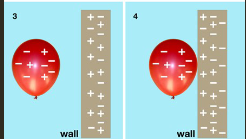Section 1 & 2 - Electrical Principles & Technologies
Section 1:
Definitions:
Charge separation
Electrical discharge
Electrical current
Circuit
Electrical energy
Ampere
Short Circuit
Electrochemical cell
Electrolyte
Electrolysis
Knowledge:
1. What charge does an electron have? A negative one (-)
2. What charge does a proton have?A positive one (+)
3. How does a balloon stick to the wall?By adding electrons to the surface of the balloon, he wall becomes more positively charged than the balloon

4. The Laws of Electrical Charges:Opposite charges attract, like charges repel
5. What is the difference between a conductor and an insulator?(Conductor) material that electric charge can move through easily, (Insulator) Substance that strongly resists the flow of electricity
6. What are some examples of conductors and insulators?(Conductors) Water, metals - (Insulators) Rubber, paper
7. What is the relationship between voltage, a volt, and a voltmeter?Voltage = how much electrical energy a charged particle carries, A volt is the unit used to measure this, A voltmeter measures the electrical energy a charged particle carries (through volts)
8. What are the minimum three things you need in order to complete a circuit?
9. Electrical safety practices?Fuses, Circuit Breakers (and third prong in plug)
10. How fuses and circuit breakers work?Fuses = thin piece of metal that melts when the current is too high, Circuit Breakers = Have a spring trip mechanism that stops the flow of current
11. How lightning rods work?They make it so that the strike lands on the insulated rod & balanced out the number of electrons which come from the strike.
12. What is the difference between a dry cell and a wet cell?Dry Cell = A cell that has its electrolyte in the form of a paste, Wet Cell = An electrochemical primary cell having a liquid electrolyte
13. How does a rechargeable battery work?It produces electricity through a chemical reaction. This reaction can be reversed using an external source to run electricity back through the cell.
14. What is the difference between a primary cell and a secondary cell? Primary Cell = cell that produces electricity by means of a chemical reaction that cannot be reversed, Secondary Cell = rechargeable Cell
15. What is electroplating?The use of electricity to coat a thin layer of metal onto an object.
Section 2:
Definitions:
Resistance
Ohm’s Law
Ohm’s Calculations
Voltmeters
Ammeters
Schematic
Series Circuit
Parallel Circuit
Transistors
Microcircuits
Knowledge:
1. What happens to electrons in an insulator?They are resisted
2. What happens to electrons in a conductor?They can easily pass through
3. The difference between a resistor and a variable resistor?Resistor = device having resistance to the passage of electrical current, Variable Resistor = resistor whose resistance can be changed
4. Examples of resistors and variable resistors we might have at home
5. How is a waterfall used as a model of electricity? What are the rocks? What about the
elevation? What do they represent?
6. Making calculations using Ohm’s law
7. What does a multimeter measure?
8. How do you draw a schematic diagram?
9. Proper symbols for schematic diagrams
10. What happens to the resistance if you add more loads to a series circuit?
11. What happens to the resistance if you add more loads to a parallel circuit?
12. How do combination circuits work in a house?
 Knowt
Knowt
